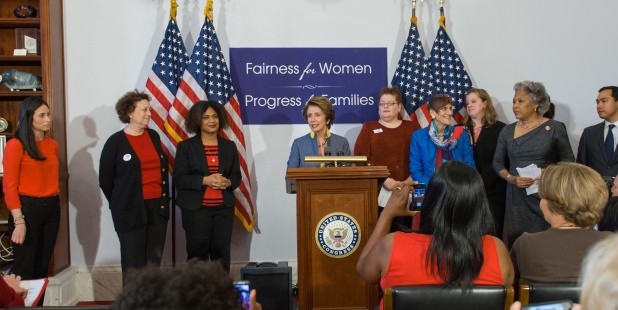Happy Equal Pay Day!

Nancy Pelosi at the 50th anniversary of Equal Pay Day in 2013.
Today is Equal Pay Day, which — to quote the National Committee on Pay Equity — “symbolizes how far into the year women must work to earn what men earned in the previous year.”
Equal Pay Day is, in many ways, symbolic; the pay gap is much more complex than “what women earn” vs. “what men earn,” as the AAUW notes:
Hispanic or Latina women are paid 89 percent of what Hispanic or Latino men are paid, and only 53 percent of what white men are paid. African American women are paid 89 percent of what African American men are paid, and that number drops to 64 percent in comparison with white men.
Still, taken in the aggregate, women tend to earn less than men. To quote a December 2014 report from the U.S Bureau of Labor Statistics:
In 2013, women who were full-time wage and salary workers had median usual weekly earnings of $706. On average in 2013, women made 82 percent of the median weekly earnings of male full-time wage and salary workers ($860). In 1979, the first year for which comparable earnings data are available, women earned 62 percent of what men earned.
We’ve come a little way, baby.
The National Committee on Pay Equity suggests that women form WAGE Clubs, where “WAGE” stands for “women are getting even,” as safe spaces where “women can candidly discuss pay inequality without being concerned that their statements will find their way back to their employer” and discuss ways to close the wage gap and advocate for equal pay.
But Ann Friedman, in New York Magazine, has a different idea:
It’s time to shift the focus from women to the people who employ them. Yeah, it’s good to train yourself to ask for more money. In the short term, this is probably your best shot at fair compensation. As a freelancer, I haggle over my pay rate almost every week, and it does get easier the more I do it. But asking women to take responsibility for closing the pay gap with their ace negotiating skills is sort of like teaching women self-defense as a way of addressing sexual assault. It puts the burden on women to figure this out as individuals — it doesn’t ask much of employers, and it doesn’t really address the bigger issue.
The bigger issue is complicated and multi-faceted and incorporates everything from biological prejudices to racial prejudices to homophobia and transphobia. Women, as an aggregate, get paid less than men, and mothers don’t get the same opportunities or workplace treatment as fathers, and transgender women, as American Progress notes, might see their earnings drop by a full 30 percent after they transition.
Will there ever be a year where we don’t need an Equal Pay Day? Probably not. Even as the wage gap continues to close, there will likely still be groups of women who are paid less than their male counterparts, or who are paid less than white cisgender men and women.
So let’s continue to talk about Equal Pay Day, every year.
Photo credit: Nancy Pelosi
Support The Billfold
The Billfold continues to exist thanks to support from our readers. Help us continue to do our work by making a monthly pledge on Patreon or a one-time-only contribution through PayPal.
Comments